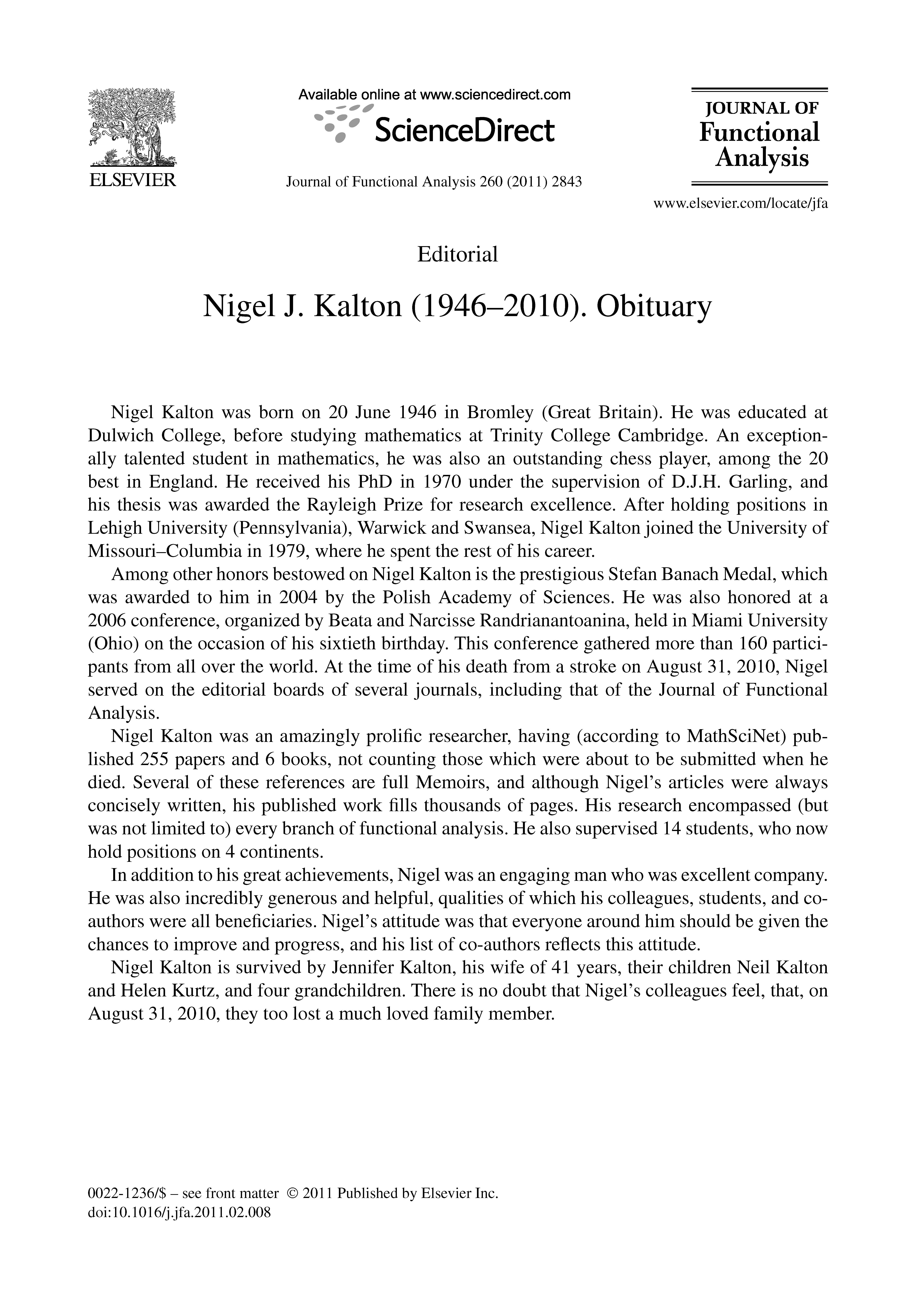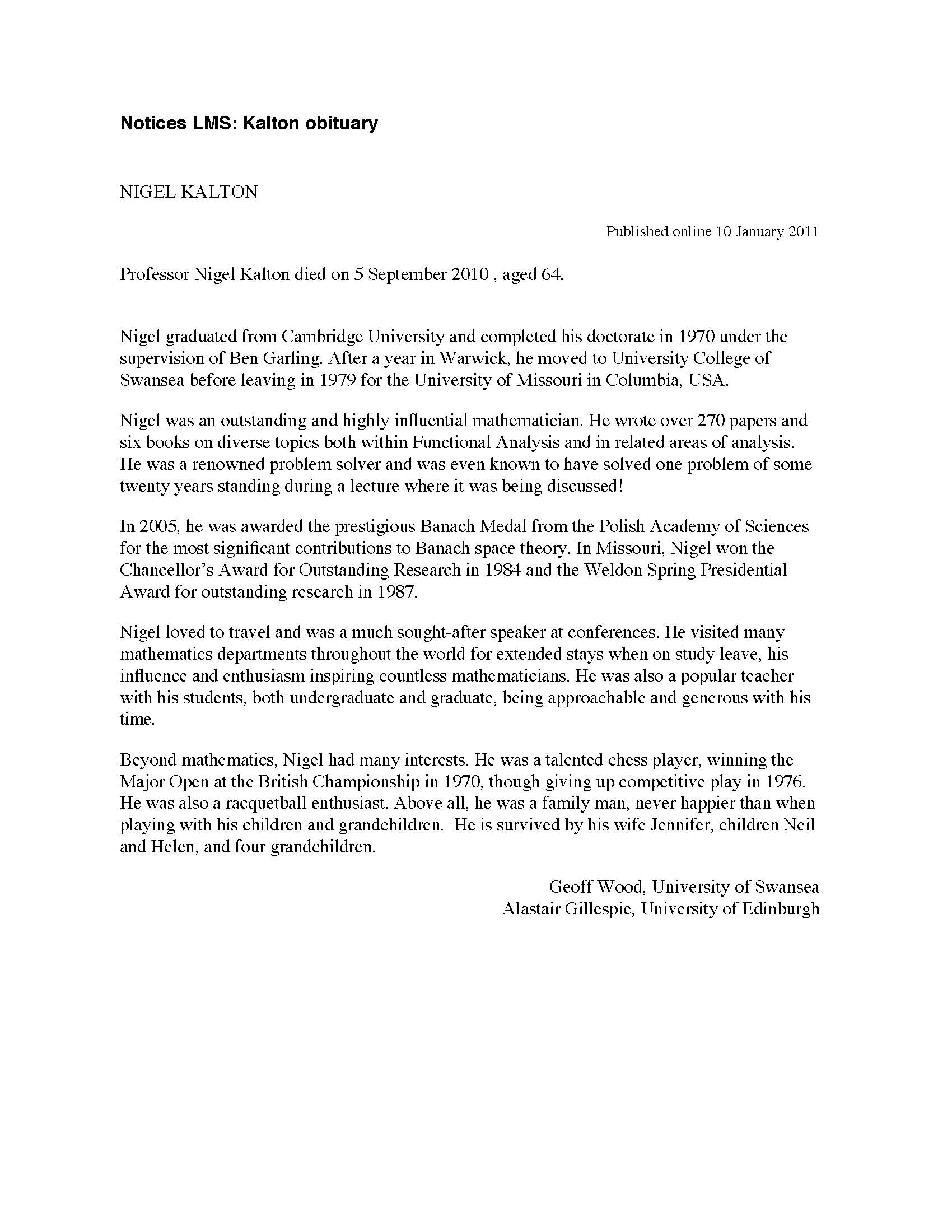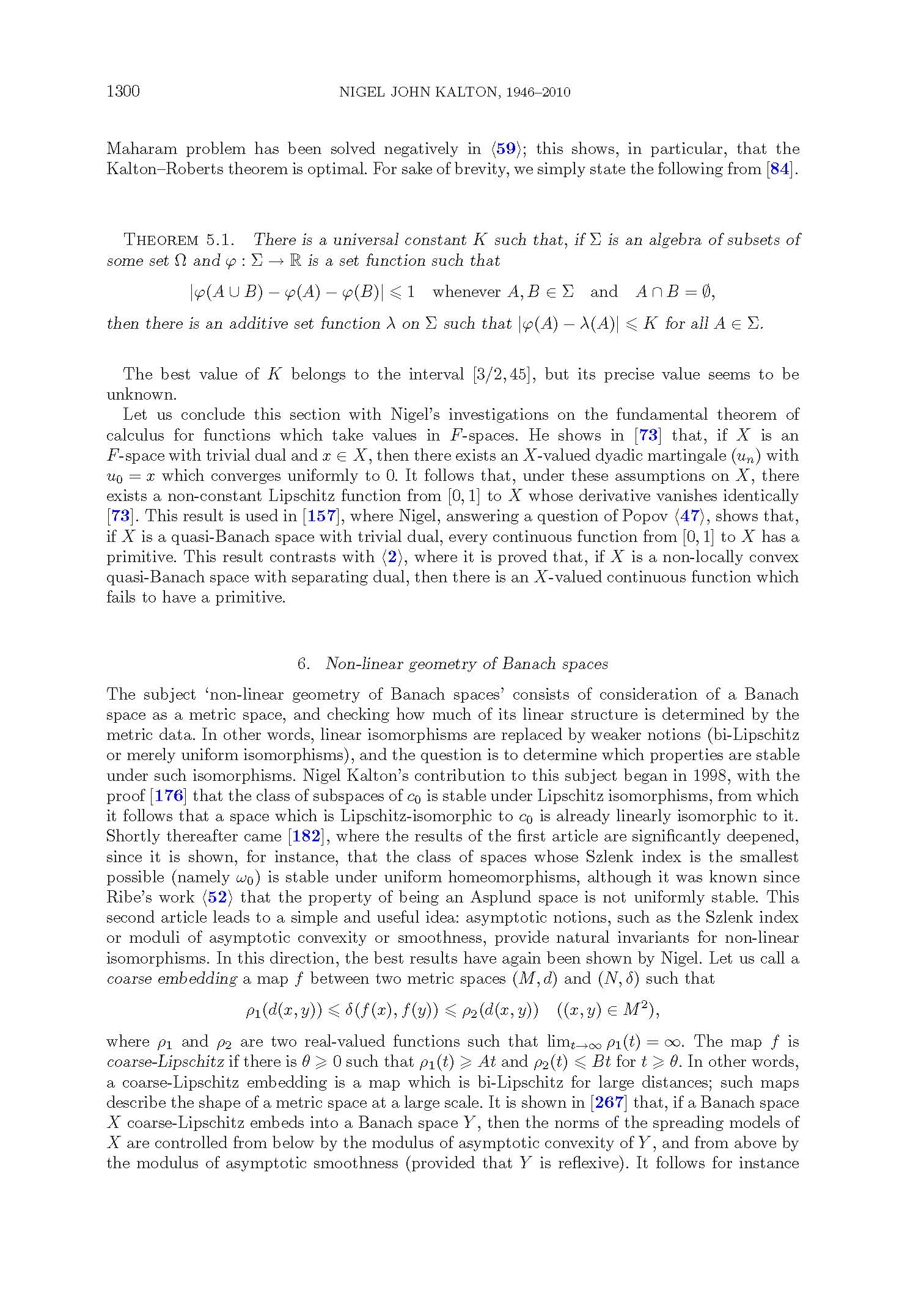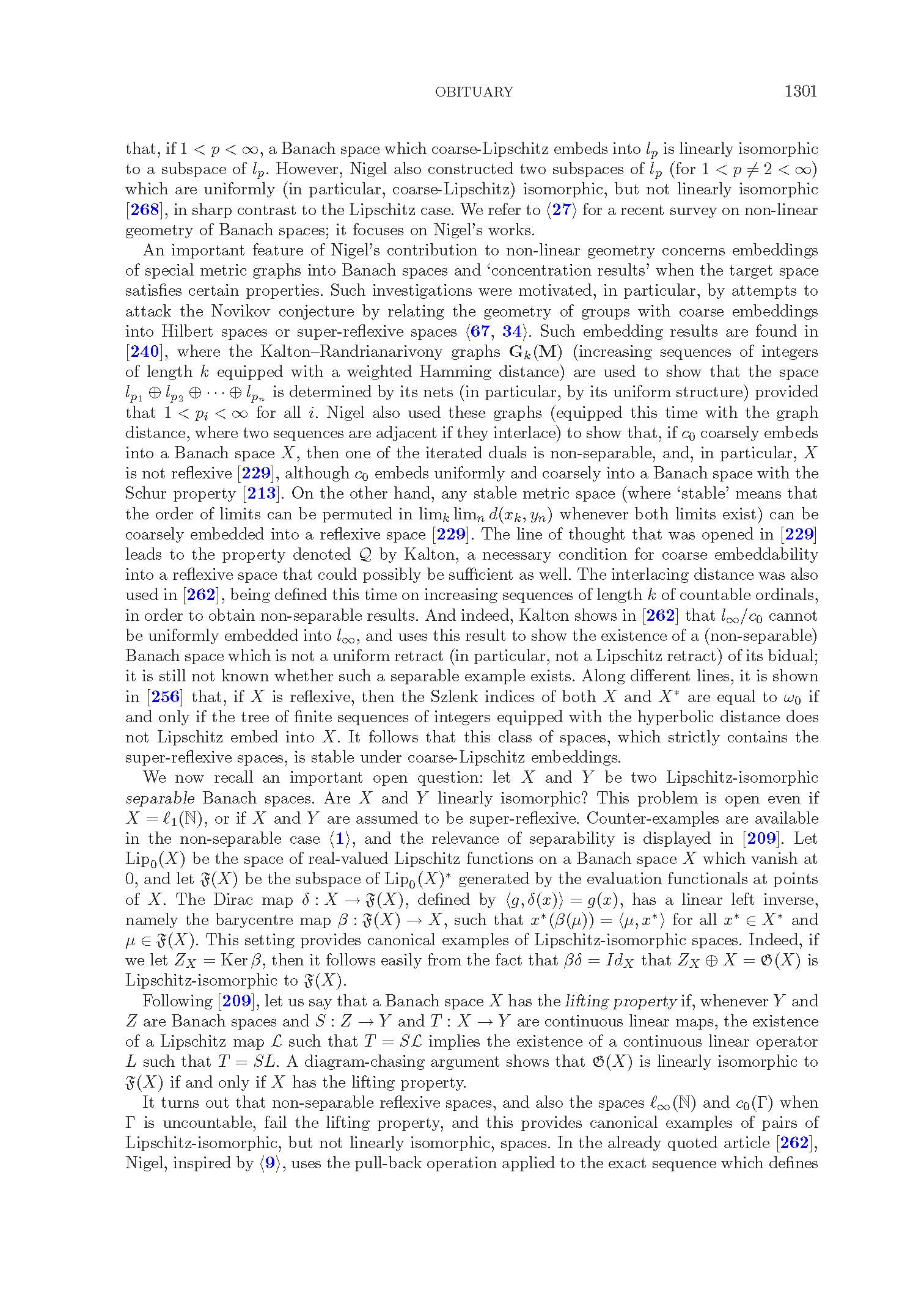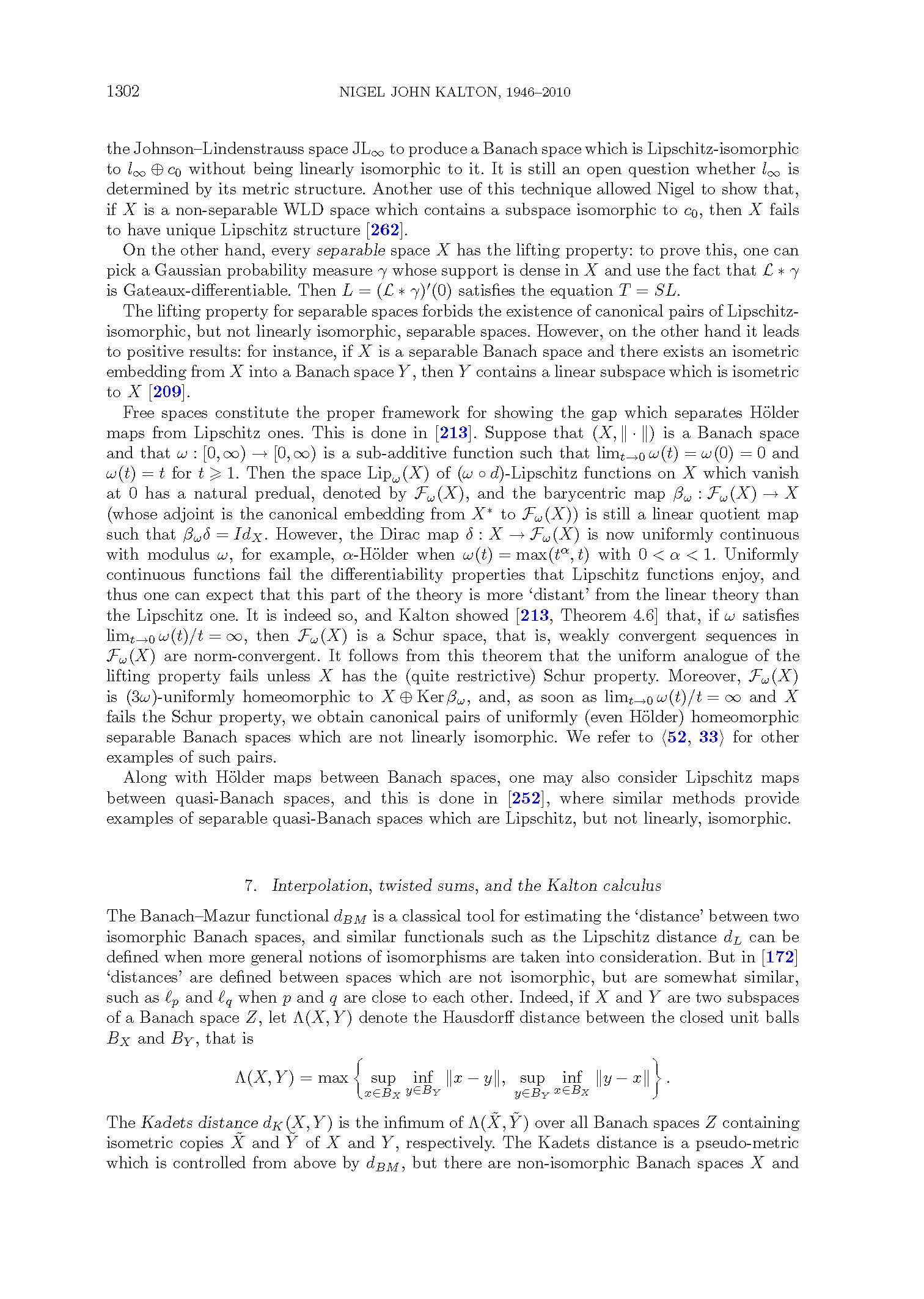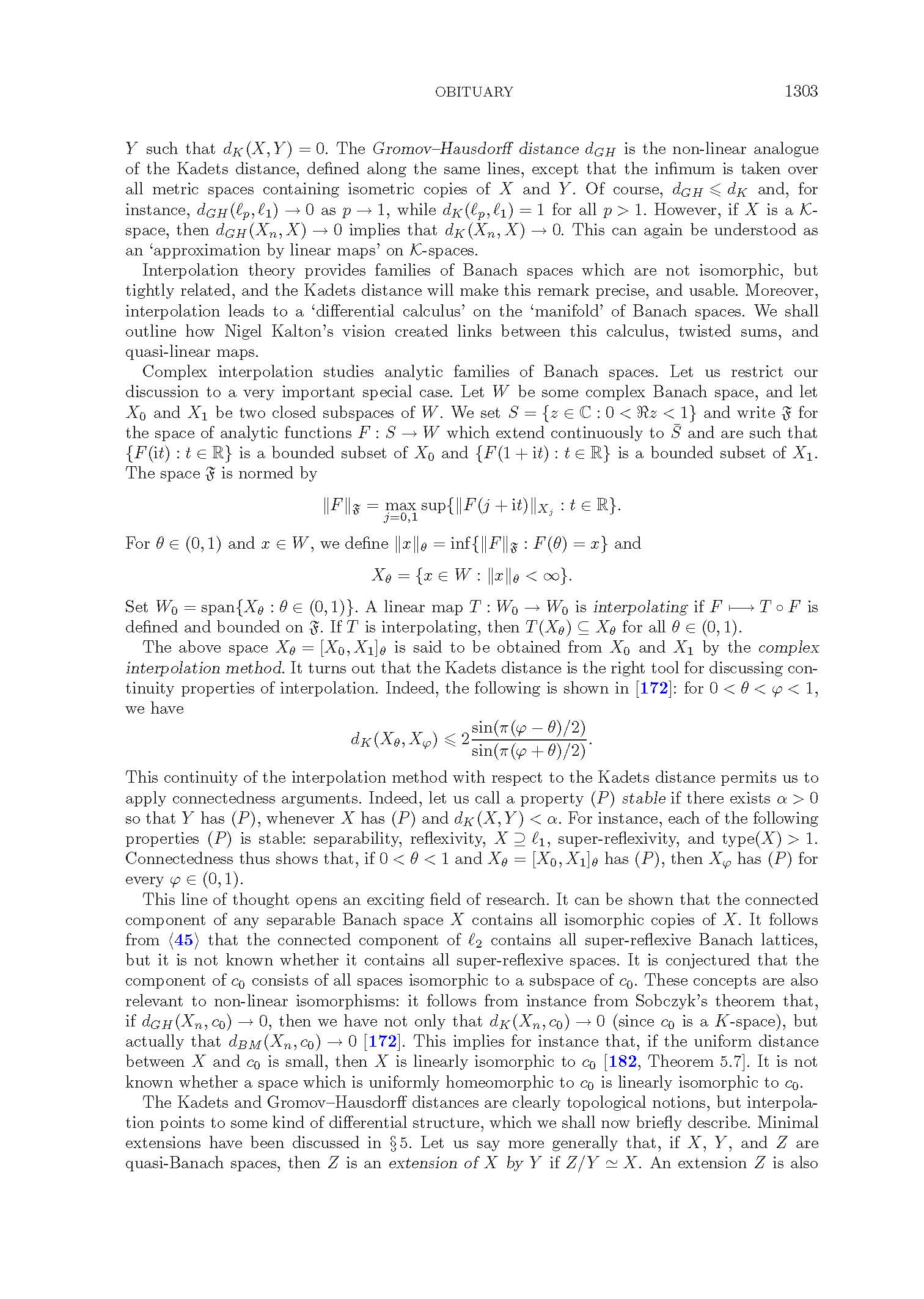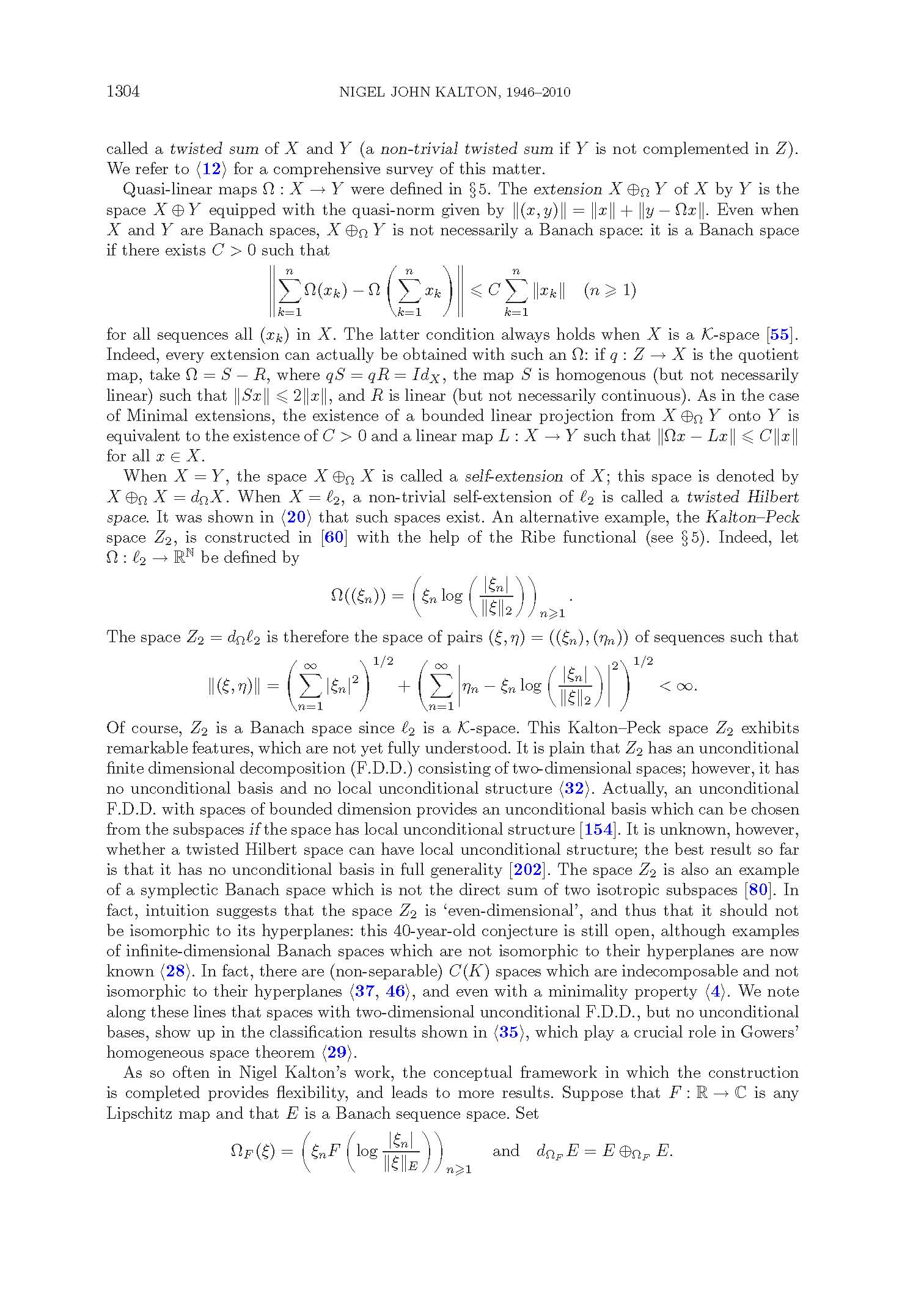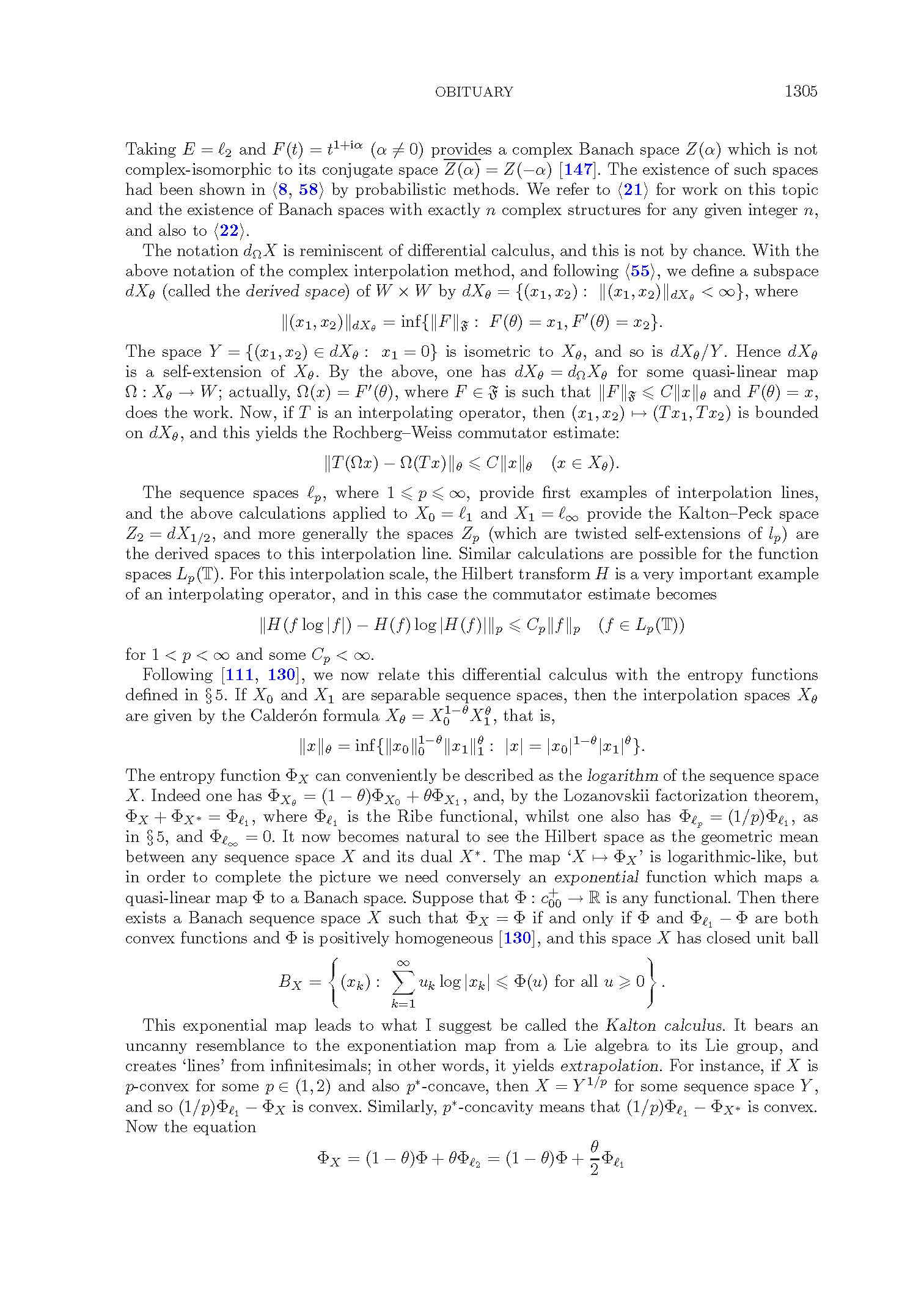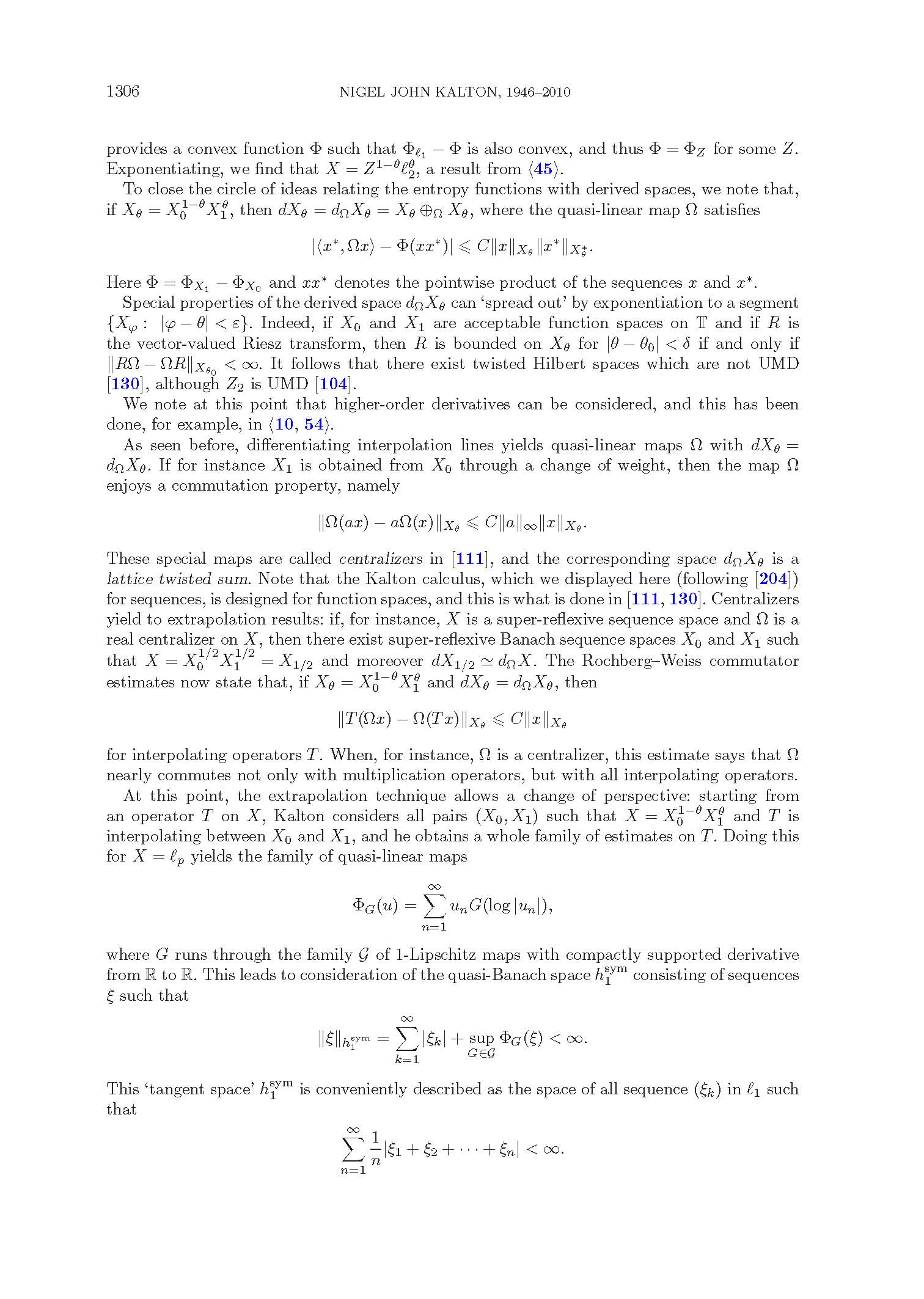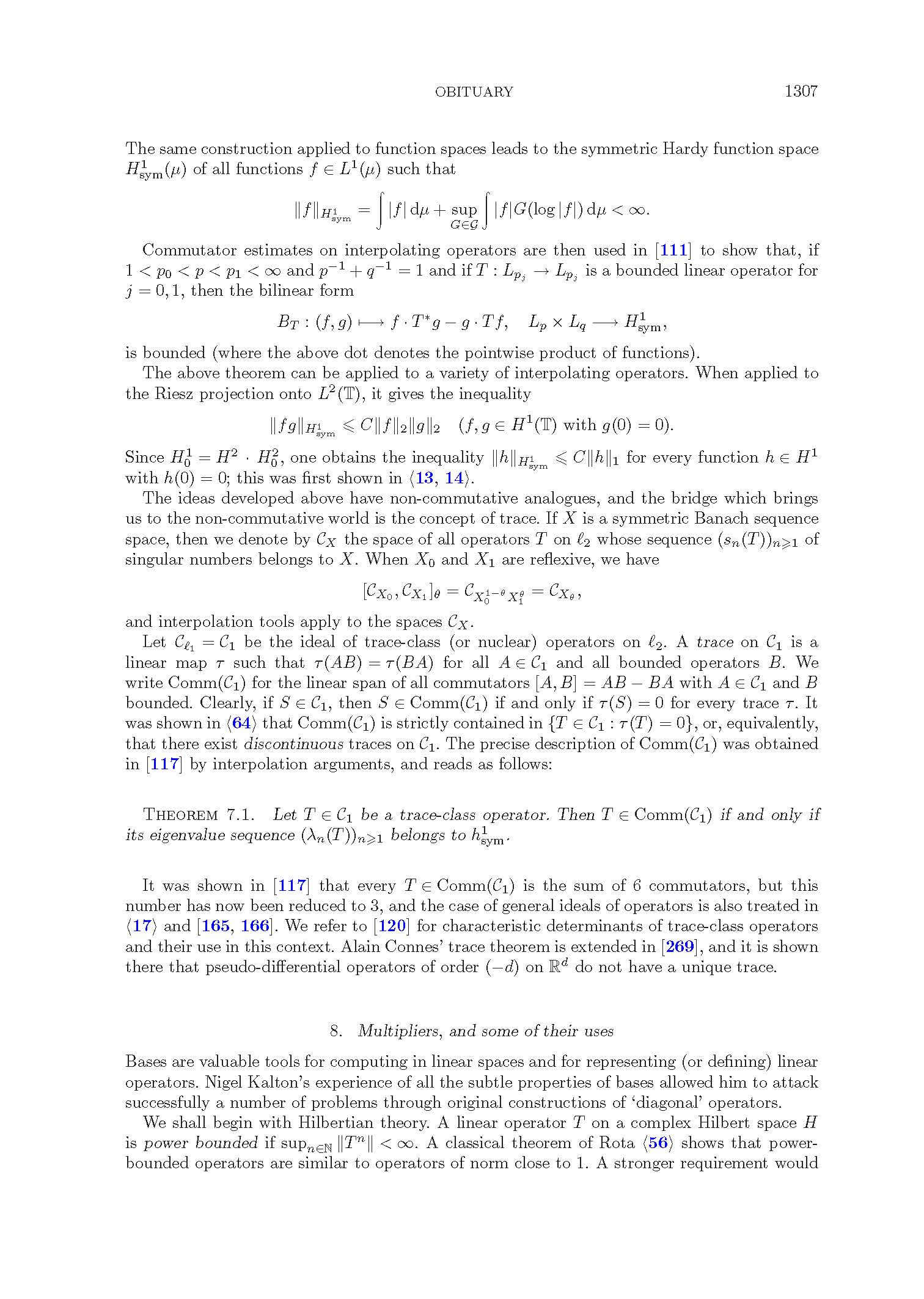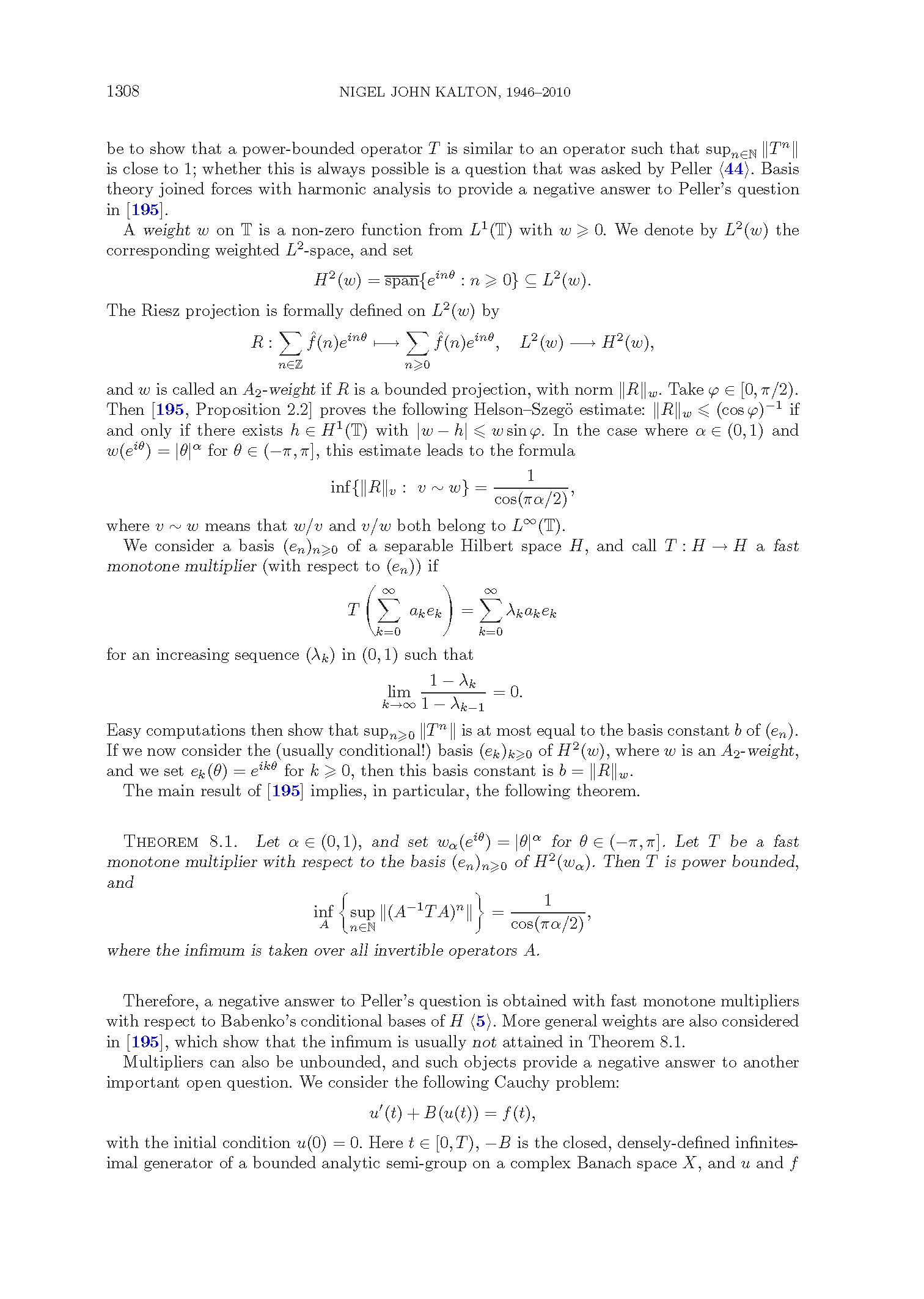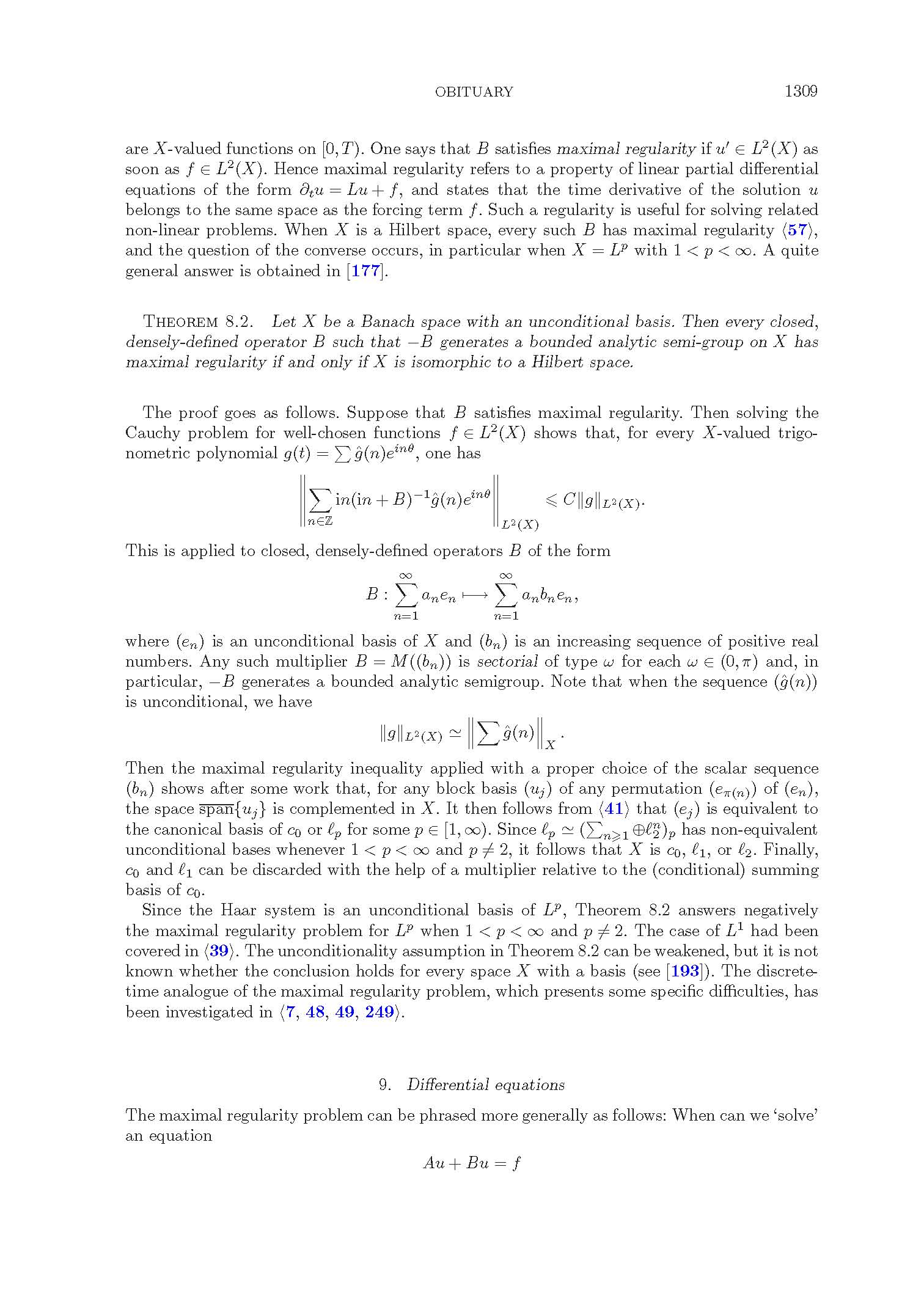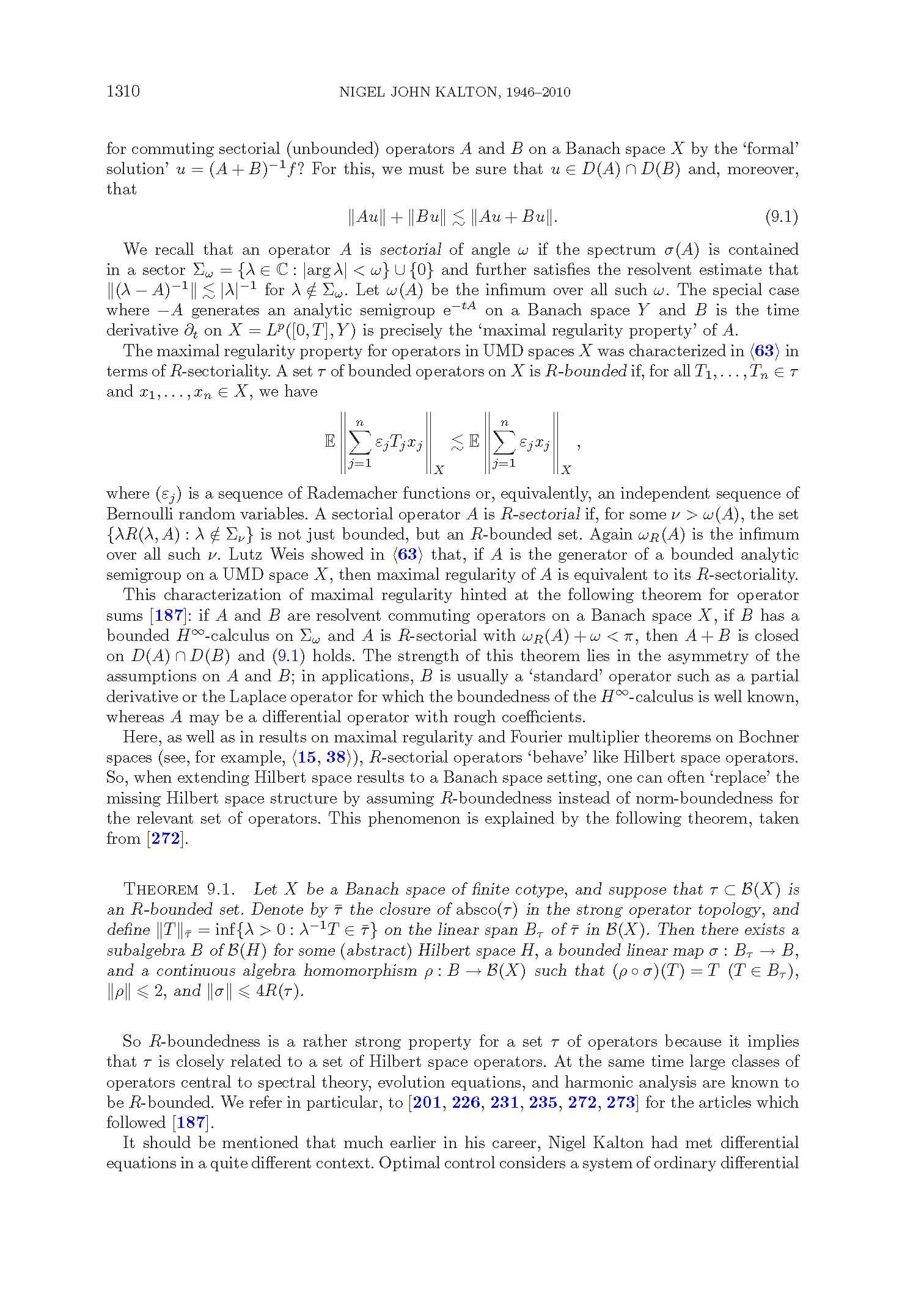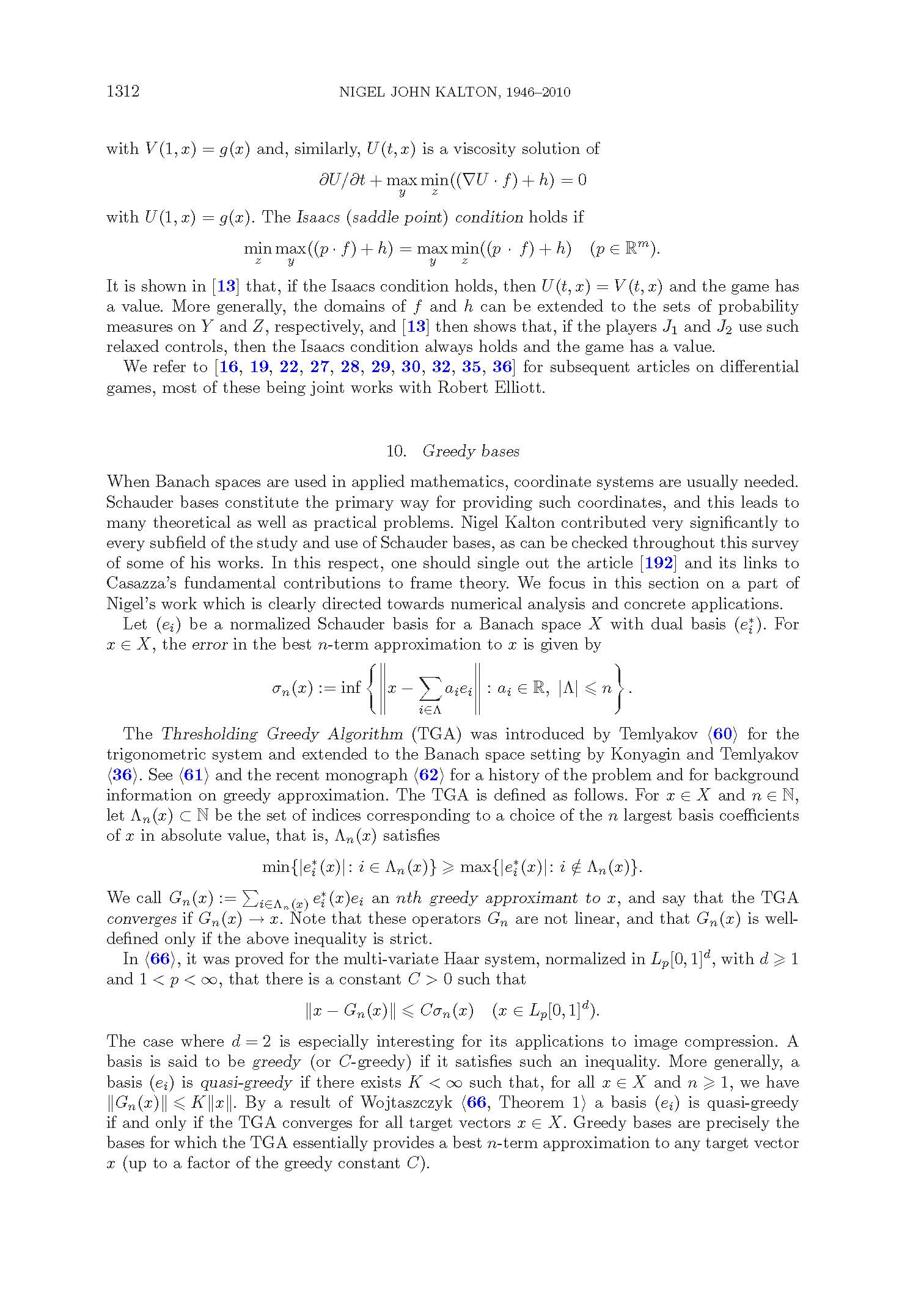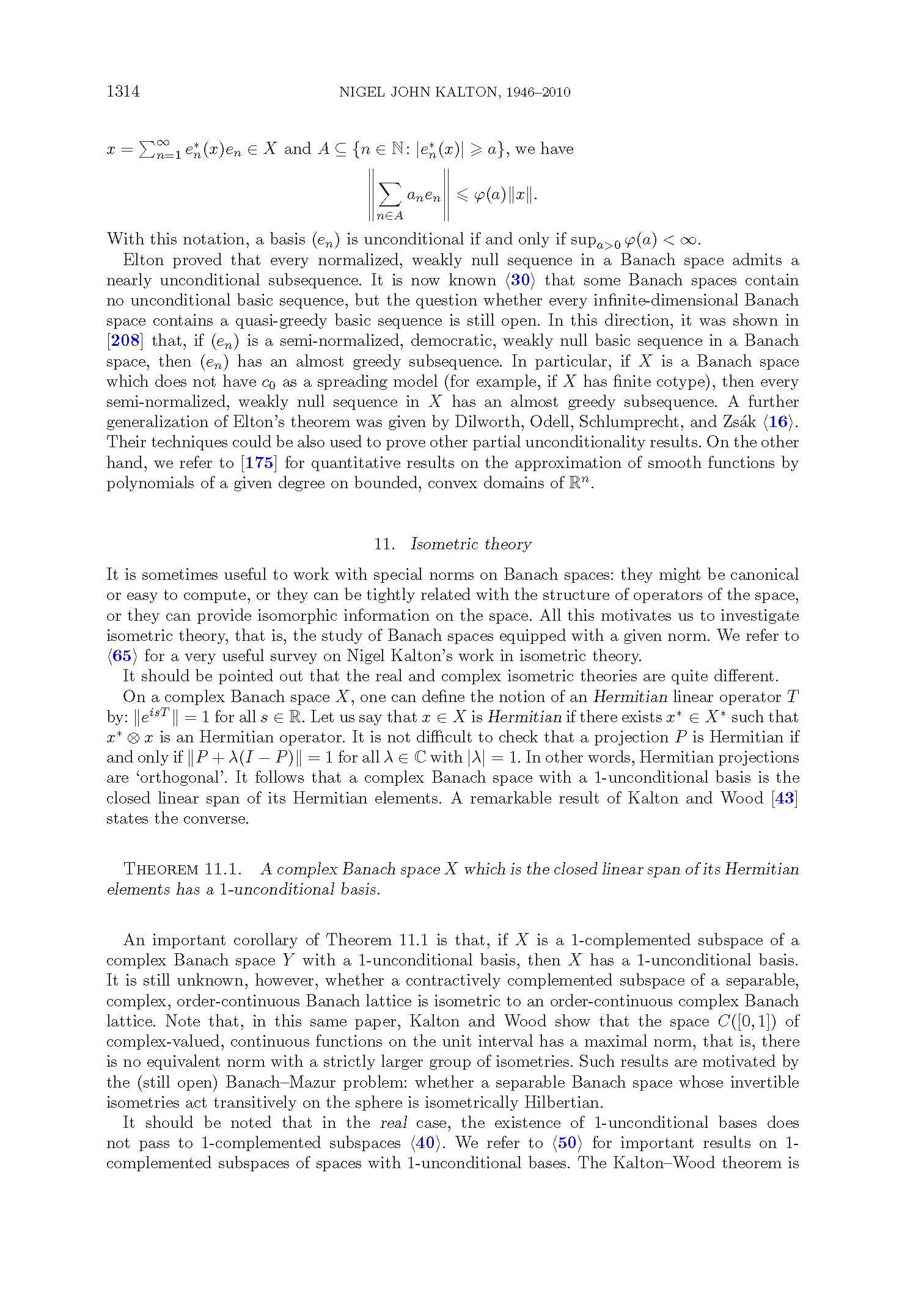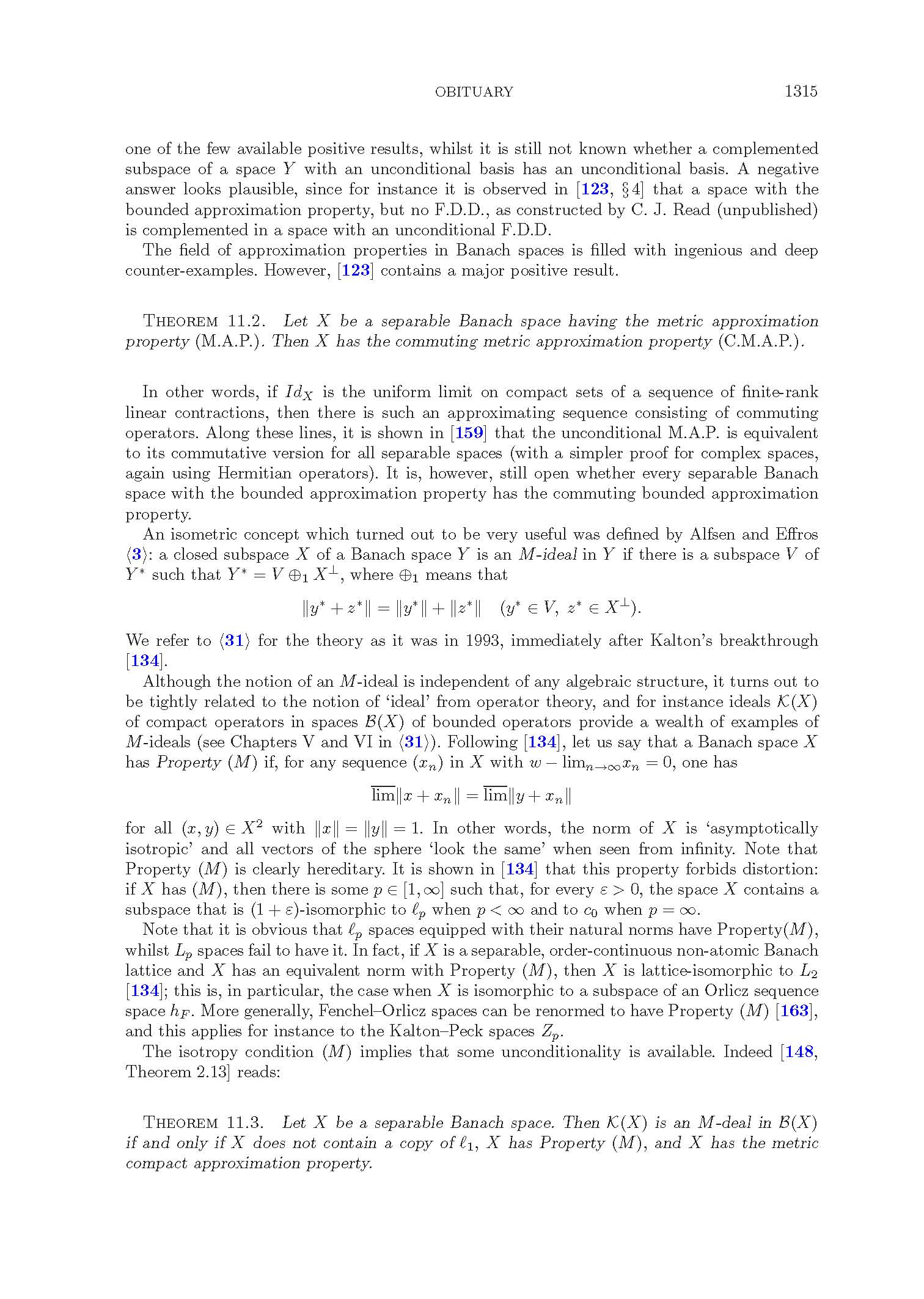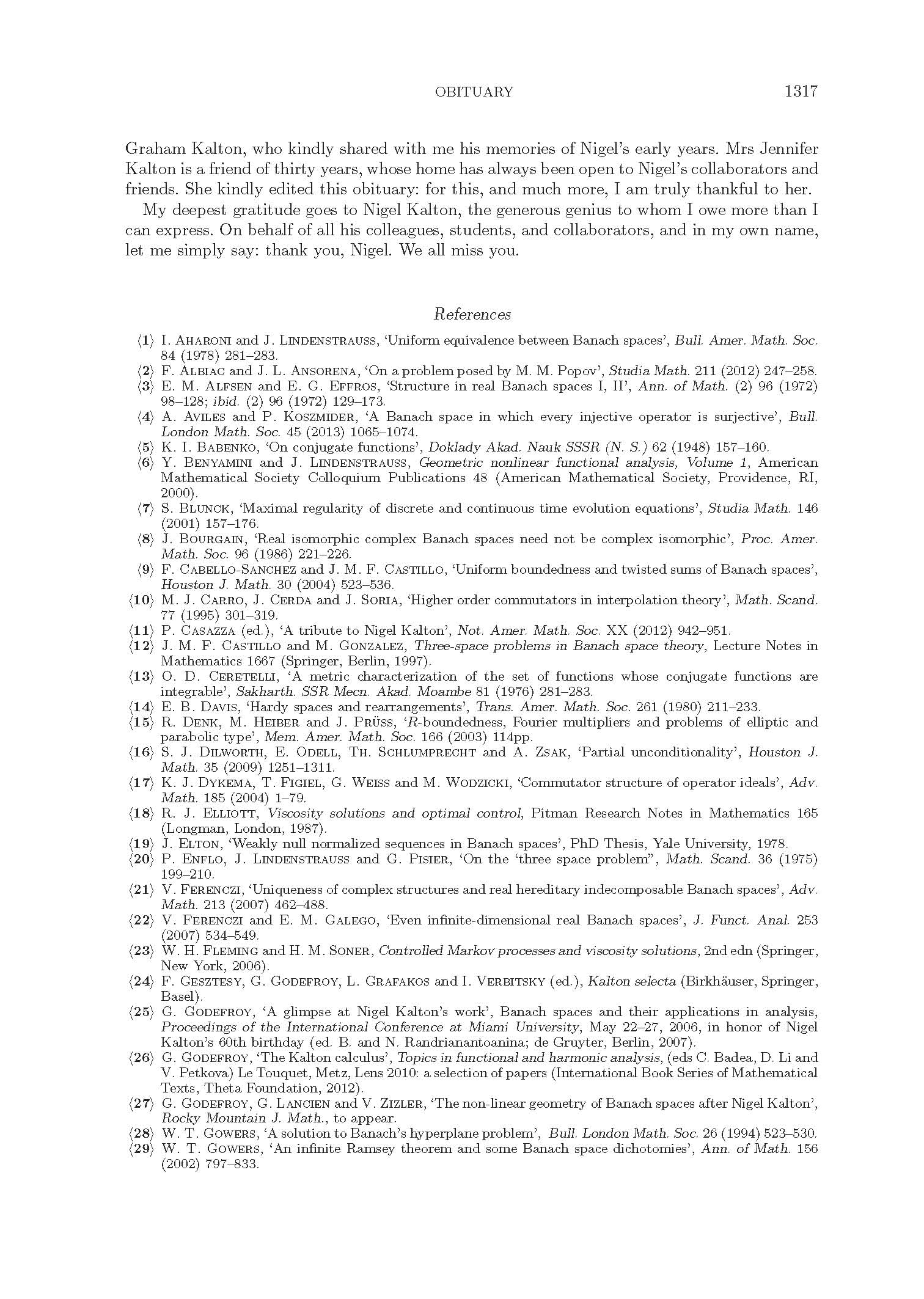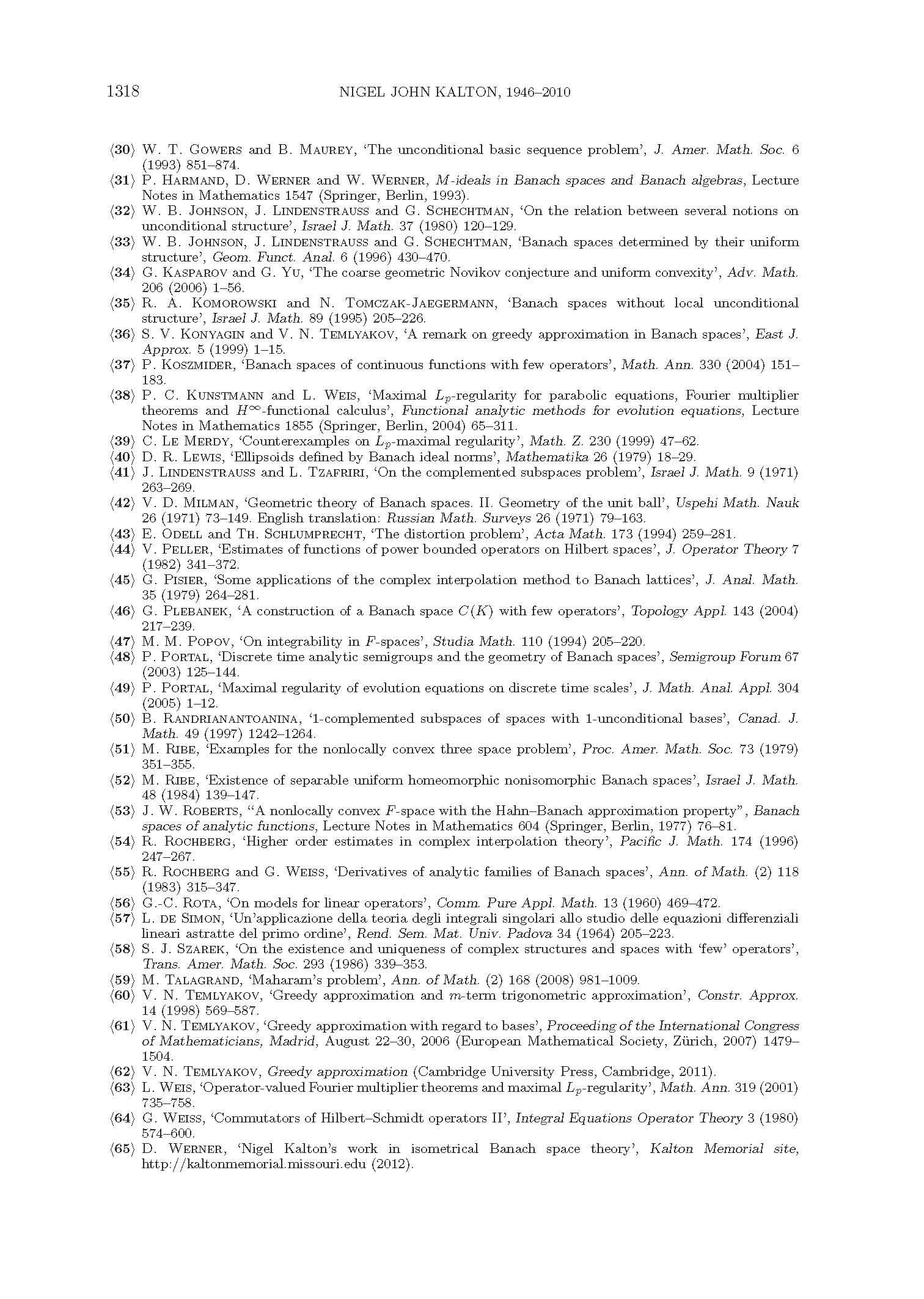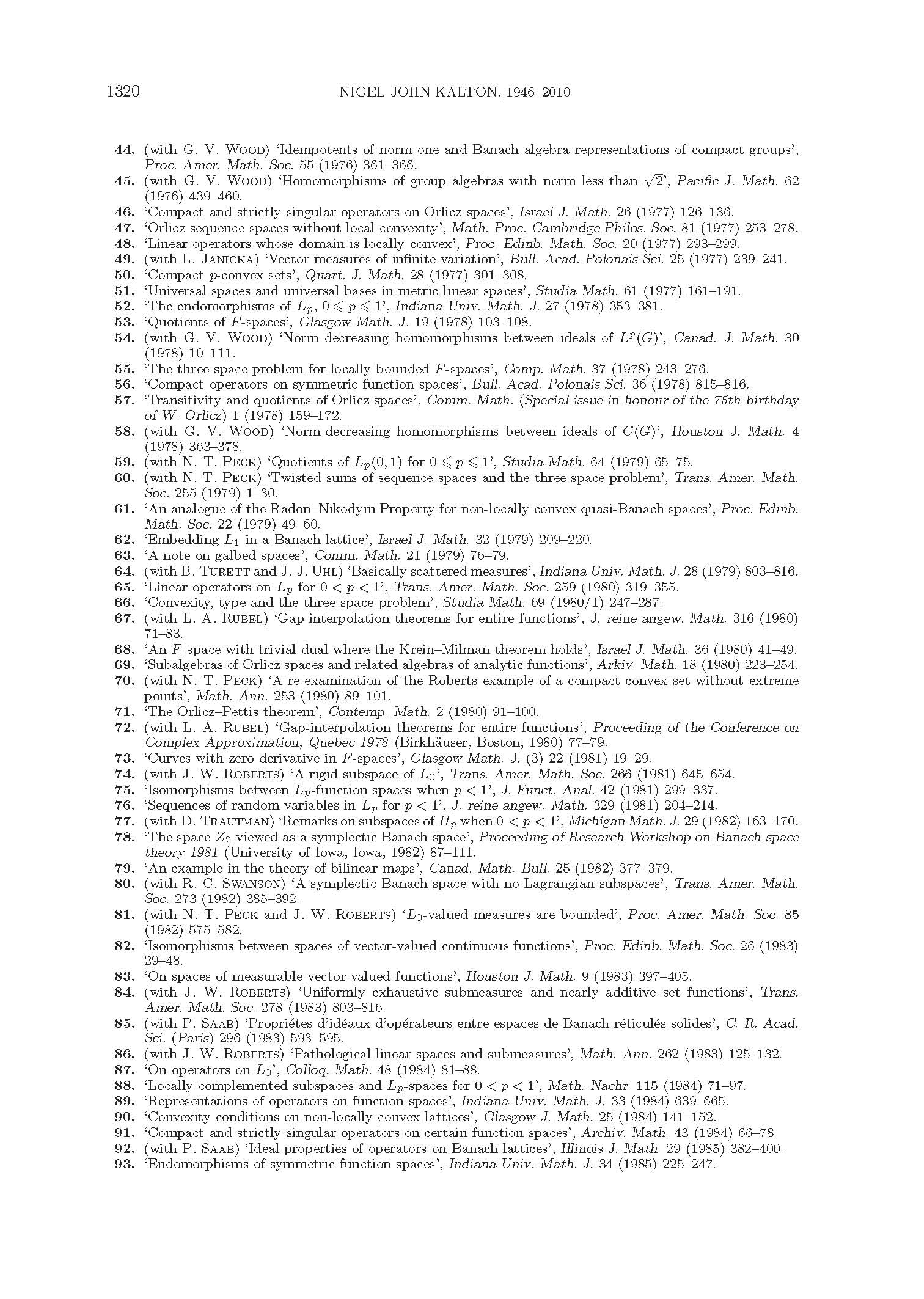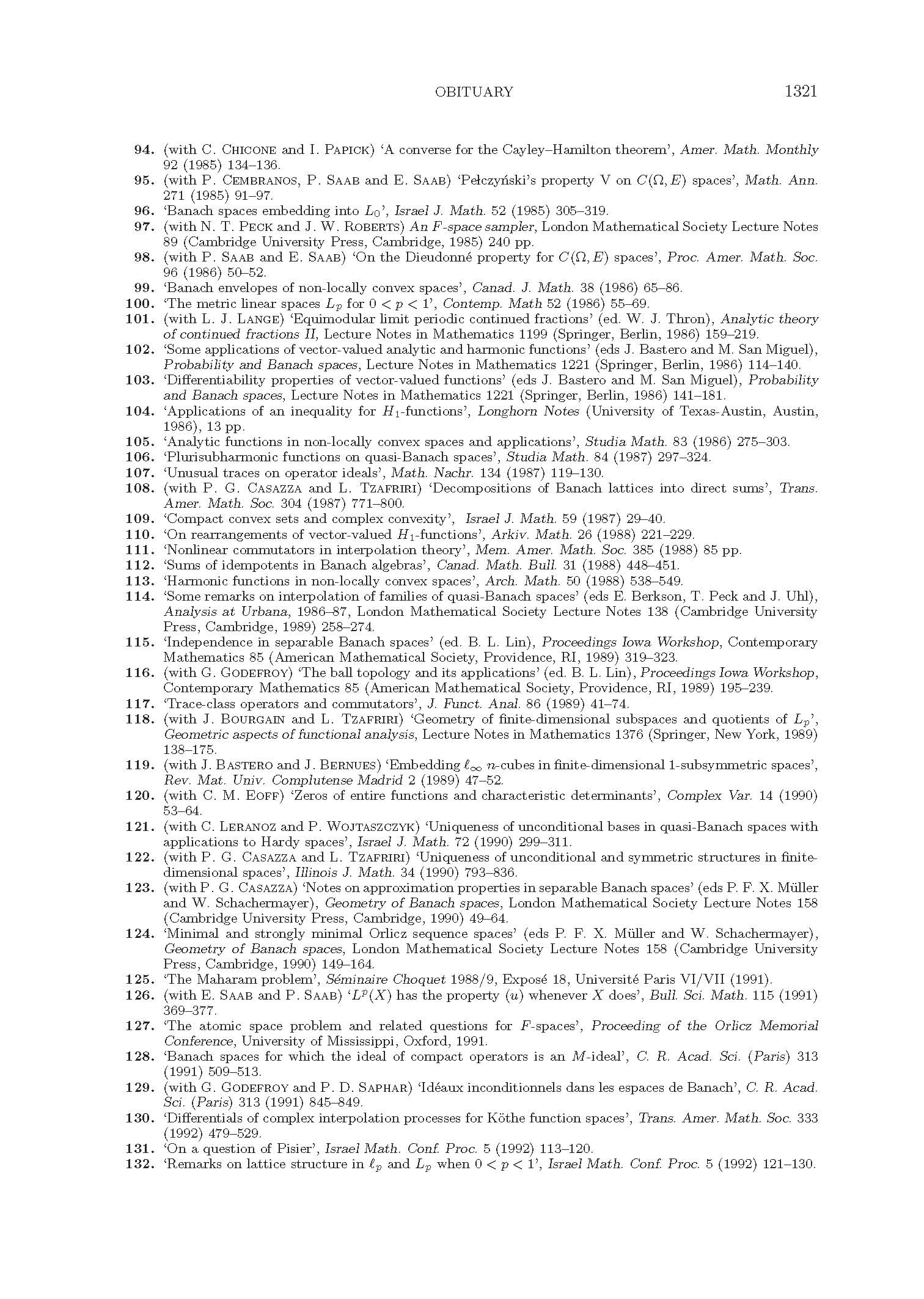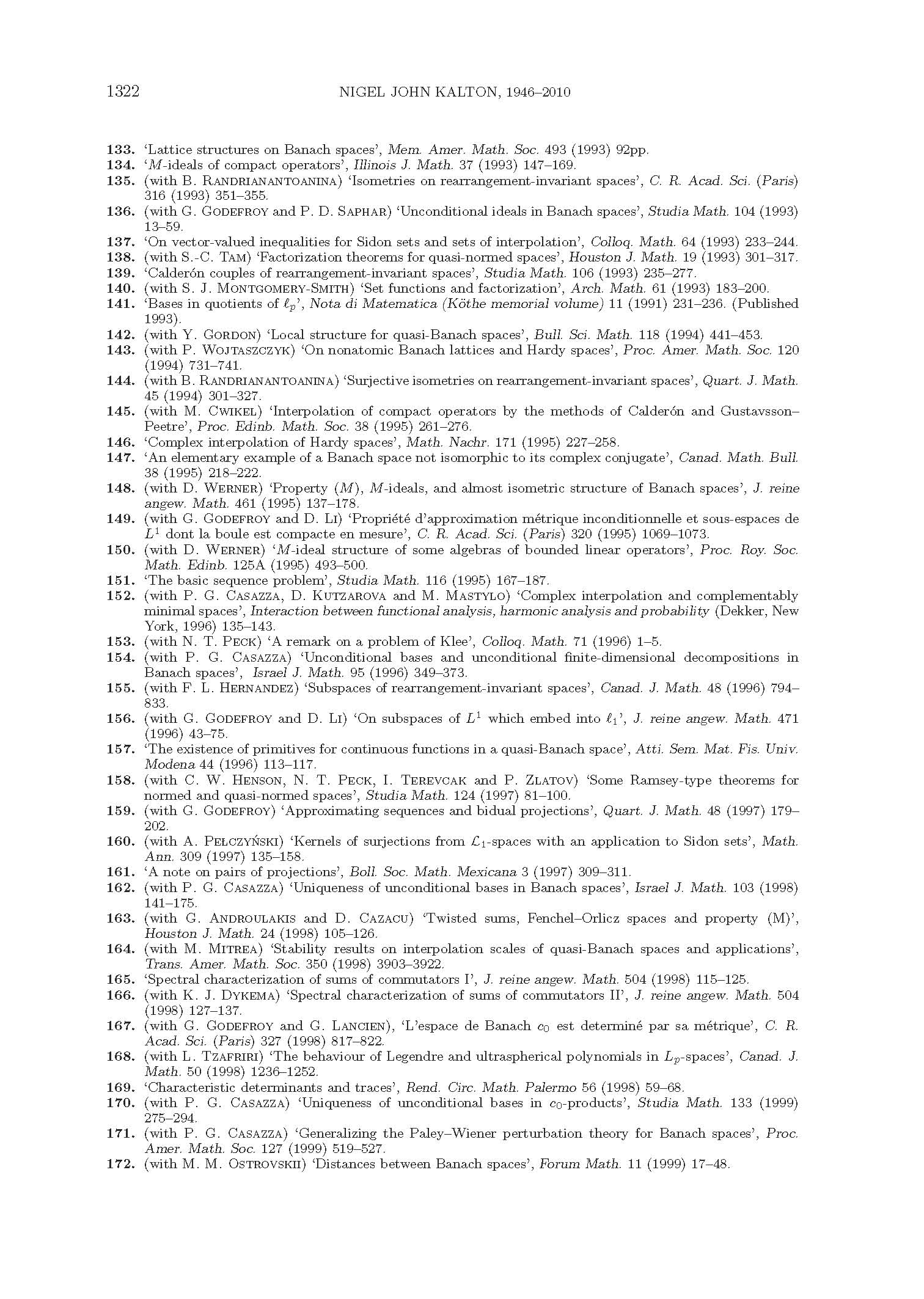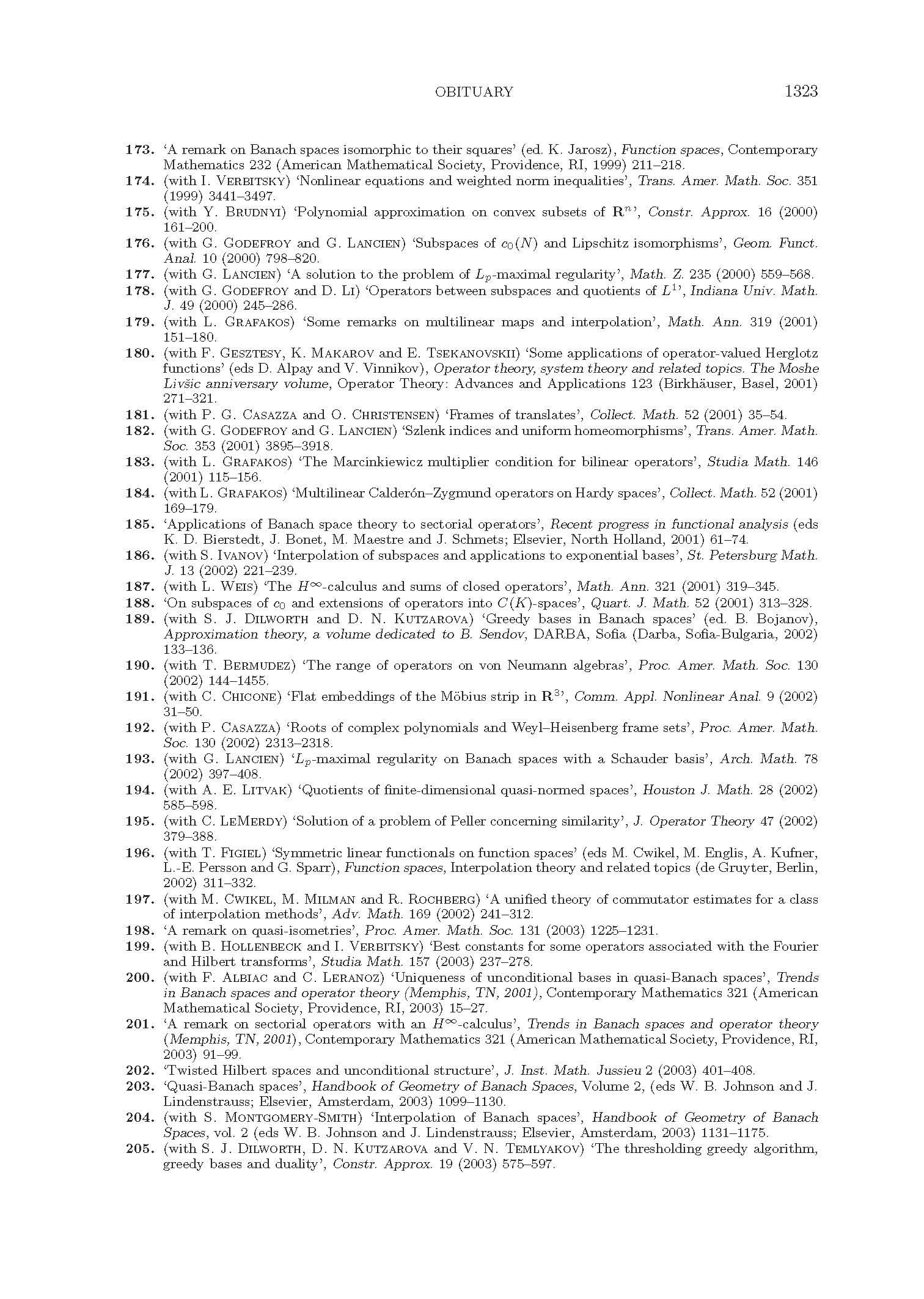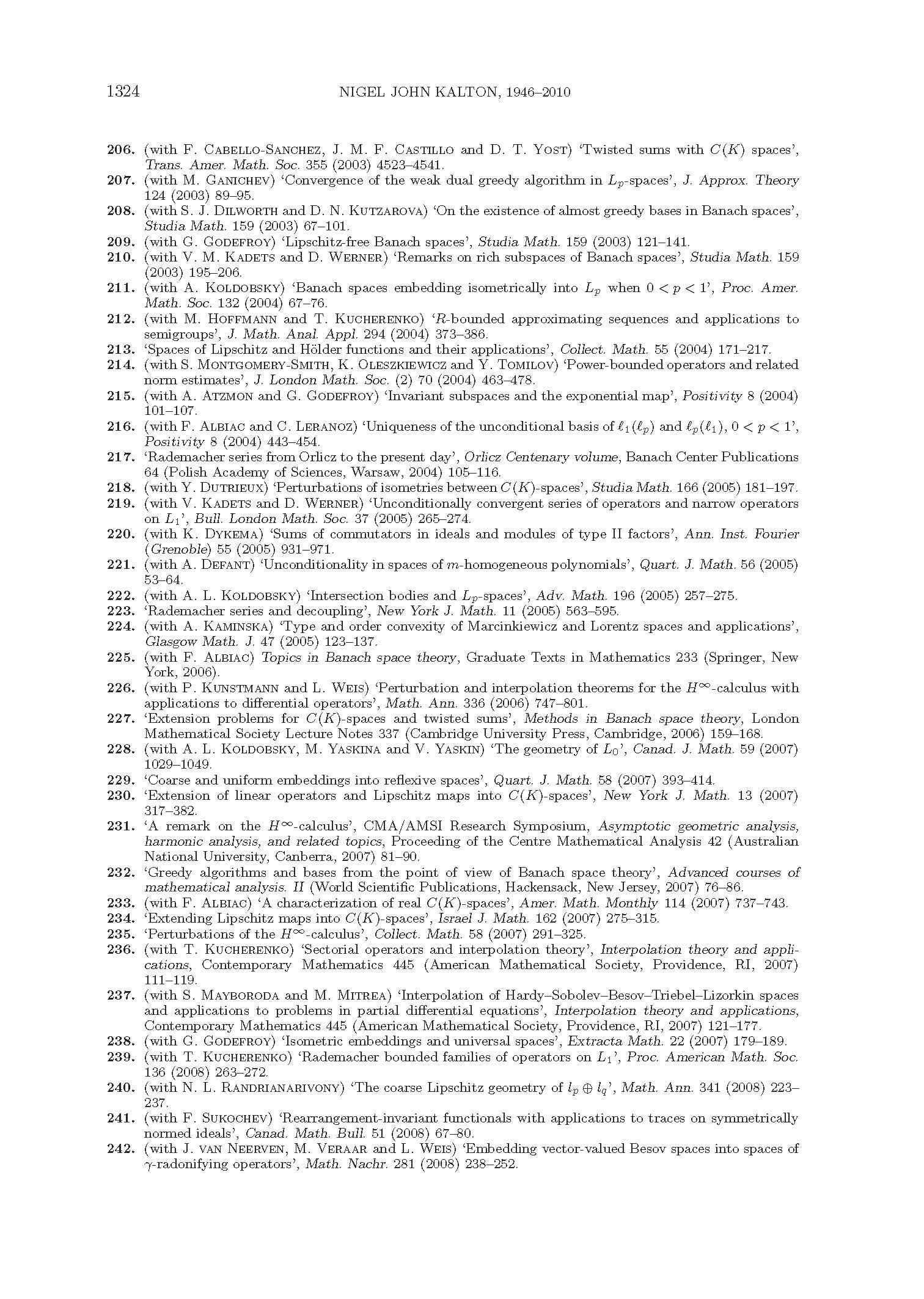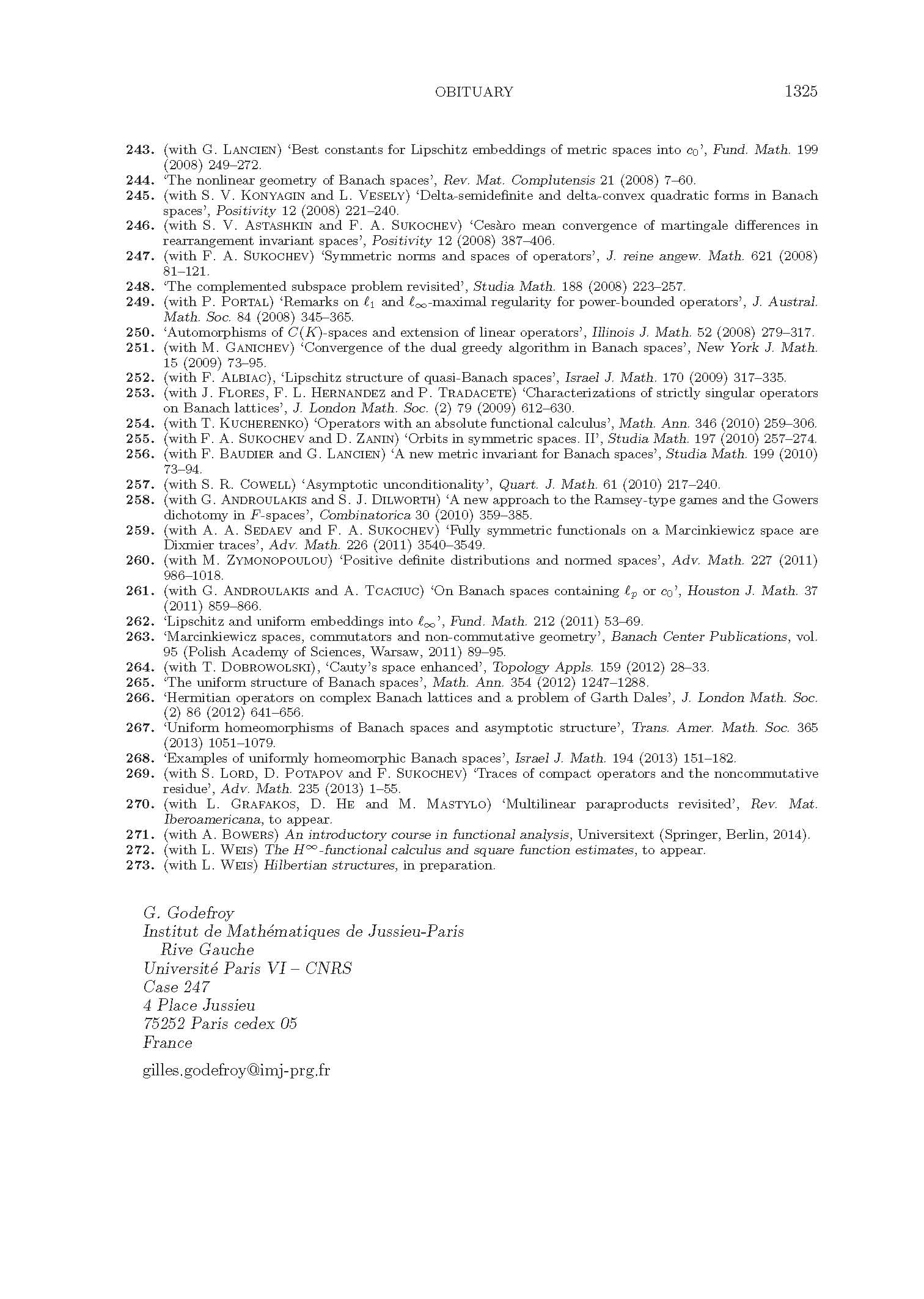
Home | CV & Publications | Banach Medal | Collaborators | On Kalton's Work | Remembering Nigel | Chess | Picture Gallery | Obituaries

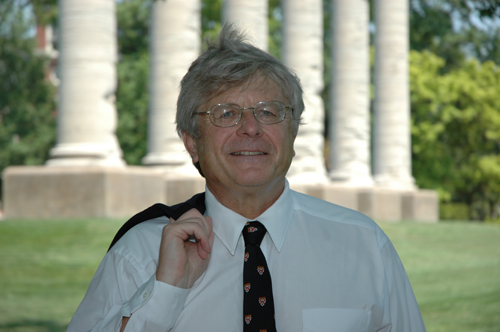

Nigel Kalton: Mathematics across the Atlantic
Professor Nigel Kalton, a leading British mathematician long resident in the USA, died from a stroke on 31 August aged 64.
Kalton inspired tremendous respect from his mathematical peers, for the great depth and breadth of his mathematical output (he wrote some 270 papers and six books), his skill in problem-solving, his ferociously hard work – he was affectionately known as `The Bulldozer' – and his endearing personal qualities.
Nigel Kalton was born on 20 June 1946 in Bromley, the son of Gordon and Stella Kalton (the name Kalton is an anglicized form of the original German family name). He was educated at Dulwich College, where he excelled at both mathematics and chess. He played on the College team with Ray Keene (who later became Britain's second chess grandmaster), once beating him in the Dulwich College championship. He studied mathematics at Trinity College Cambridge, and met his wife Jennifer at Cambridge. He and Keene also played chess for Trinity College (by far the strongest College team in Cambridge). He represented Cambridge in the Varsity match against Oxford, twice came second in the Cambridge University chess championship, and played successfully at national level (some of his competitive games may be found on the internet).
After his undergraduate studies, Kalton did research in mathematics at Cambridge, working on Banach spaces (infinite-dimensional extensions of ordinary space) under Dr D. J. H. (Ben) Garling; he took his PhD in 1970. His thesis was awarded the Rayleigh Prize for research excellence. Kalton then held positions at Lehigh Unversity in Pennsylvania, Warwick and Swansea.
Kalton then moved to the USA permanently. This was partly a matter of speed of promotion, and salary. It was mainly a matter of working conditions – research grants, books and journals, and access to other specialists in his area. He taught at the University of Illinois and Michigan State University before moving to the University of Missouri, where he spent the rest of his career, apart from several visiting positions. He maintained his academic links with British mathematics, but his career moves, and the reasons for them, are good examples of the well-known phenomenon of the `brain drain'.
Many stories were told about the speed, power and penetration of Kalton's thinking. On one occasion, the French mathematician Gilles Pisier gave a talk on an approach by Le Merdy to an open problem due to the Russian mathematician Vladimir Peller. Kalton was in the audience, immediately engaged with the problem, and solved it shortly afterwards (joint work with Le Merdy in 2002). On another occasion, he was consulted by Jerry Lange about a problem on continued fractions that he had been working on for fifteen years. Kalton solved it within 48 hours; his solution was later used to solve a problem of the great Indian mathematician Ramanujan. Kalton was described by colleagues as one of the few genuine geniuses of the mathematical world.
Kalton's honours included the prestigious Stafan Banach Medal, named for the Polish mathematician who gave his name to the spaces on which Kalton did much of his work. This prize was established by the Polish Academy of Sciences in 1992 in honour of the centenary of Banach's birth. Kalton was also honoured by a conference for his sixtieth birthday at Miami University, Ohio and by the resulting conference proceedings. Kalton served extensively on the editorial boards of learned journals, and had 11 PhD students.
On a personal level, Kalton was an engaging and modest man, despite his great achievements, and excellent company. He was, however, famously competitive. He was a devoted family man, and would play for hours with his children when young, and then with his grandchildren – but they complained that he never let them win anything.
Nigel Kalton is survived by his wife Jennifer of 41 years, their children Neil and Helen, and four grandchildren.
Nigel Kalton, mathematician, born 20 June 1946, died 31 August 2010, Columbia, Missouri, aged 64.
Obituary from the London Times
From the Columbia Missourian
August 31, 2010 - Dr. Nigel Kalton was a giant in the world of mathematics and on MU's campus.
"There's something like 40,000 mathematicians in the world," said Pete Casazza, a math professor who taught with Dr. Kalton for 27 years. "Everyone thinks we're all geniuses. But in reality, there are only 50 to 100 real geniuses. Nigel was one of them."
Dr. Kalton died Tuesday, Aug. 31, 2010, of a stroke. He was 64.
"If you could have the chance to sit around and talk with Einstein, you would be very lucky. And that's the way we felt," Casazza said.
Dr. Kalton was born on June 20, 1946, in Bromley, England, to Gordon and Stella Kalton. He met his wife, Jennifer, at Cambridge University. They married in 1969 and moved to Columbia 10 years later.
"They hired him to try to do something about this department," Casazza said, referring to MU's mathematics department. "He pushed and pushed and pushed to make this into a major math department."
Excellent researchers "usually publish about 70 papers during their career," Casazza said. "Nigel published more than 270, along with half-a-dozen books."
The volume of research Dr. Kalton produced earned him the nickname, "The Bulldozer."
"It's difficult to describe what a towering figure he was," Casazza said. "He would take a difficult problem that very smart people couldn't solve for years. He wouldn't just solve it. He would have three different proofs for it, just because he didn't like the first one."
Igor Verbitsky, a professor in MU's mathematics department who wrote two papers with Dr. Kalton, recalled a conference Dr. Kalton attended in Paris. Gilles Pisier, a famous mathematician, was lecturing about Peller's Problem, which had been unsolved for 20 years. Sitting in the audience, Dr. Kalton solved the problem before the lecture was over.
"His solution was very elegant," Verbitsky said. "It's strikingly beautiful."
Dr. Kalton, however, did not let his intelligence affect the way he interacted with his colleagues.
"Here was a person who was one of the top mathematicians in the entire world, yet he was so unassuming," Casazza said. "He could have walked around looking down on the world, but he was so genuine."
Dr. Kalton was also famous for his competitive streak, his son, Neil Kalton, said.
"It didn't matter what it was," he said. "He was never, ever going to let you win."
In addition to being a world-renowned mathematician, Dr. Kalton was known as a family man. His wife, Jennifer Kalton, said they enjoyed traveling the world together during their 41 years of marriage.
He also spent much of his time with his children.
"He was one of those get-on-the-floor-and-roll-around kind of fathers," Dr. Kalton's daughter, Helen Kurtz, said. "I remember hanging onto his leg and having him drag me around the house."
He also loved to play hide-and-seek with his grandchildren, and, his children said, he always found the best hiding spots.
"We knew him to be a great dad and a great grandpa," Neil Kalton said.
Dr. Kalton is survived by his wife, Jennifer; son Neil Kalton of St. Louis; daughter Helen Kurtz of Orinda, Calif.; brother Graham Kalton of Silver Spring, Md.; and four grandchildren, Kaile and Drew Kalton of St. Louis, and Natalie and Grant Kurtz of Orinda, Calif.
His parents and sister, Pamela Kalton, died earlier.
Nigel Kalton, 1946-2010
Nigel Kalton, 64, passed away peacefully at University Hospital on Tuesday, Aug. 31, 2010, after suffering a stroke.
The family held a private cremation and there will be a celebration of his life on Friday, Oct. 1, from 1 to 3 p.m. at the Reynolds Alumni Center on the University of Missouri campus.
Nigel was born on June 20, 1946, to Gordon and Stella Kalton in Bromley, England. As a young boy it was clear Nigel was gifted in math. Nigel earned a doctorate in mathematics from Cambridge University in 1970, and received the Rayleigh Prize for excellence for a doctoral thesis. While at Cambridge, Nigel met his wife, Jennifer. They were married in 1969 and have two children, Neil and Helen.
After leaving Cambridge, he held positions at Lehigh University, Warwick University, University College of Swansea, the University of Illinois and Michigan State University before coming to the mathematics department at the University of Missouri in 1979. He was instrumental in building the math department at MU into an internationally recognized department. He consistently provided leadership within the department and across the campus. In 1984, he was appointed the Luther Marion Defoe Distinguished Professor of Mathematics, and in 1985 he was appointed to the Houchins Chair of Mathematics.
In 1995, he received the highest recognition bestowed by MU by being appointed a curators' professor. Nigel won the Chancellors Award for outstanding research in 1984 and the Weldon Springs Presidential Award for outstanding research in 1987.
In 2005, he received the highest honor in his field, The Banach Medal from the Polish Academy of Sciences that recognizes the person who has made the most significant contributions to Banach space theory. Nigel was at the top of his field in productivity, creativity, depth and breadth of knowledge, as well as research support, invited addresses, citations and the view of his peers. There are a number of fundamental results in mathematics that carry his name. Nigel was incredibly broad in his research, having worked in a dozen different areas of mathematics. He had written more than 270 research articles and books and was on the editorial board of six prestigious mathematics journals.
In 2006, Miami University of Ohio held a weeklong conference to honor Nigel's 60th birthday. Mathematicians from all over the world came to pay tribute to him, and the conference resulted in a volume of nearly 500 pages dedicated to his work. Those who knew him as a friend will always remember him for his kind, genuine and humble nature that offered no clue to his remarkable achievements.
Nigel had many interests outside of the math world including travel, chess, history and racquetball. He was famous for his competitive streak, and his grandchildren knew full well that he would never let them win at anything. He also had a playful side and the serious mathematician could turn into the biggest kid in the house. His grandchildren loved to play marathon games of "hide and seek" and listen to his silly voices.
Survivors include his wife, Jennifer Kalton of Columbia; a son, Neil Kalton and wife Carrie Kalton of St. Louis; a daughter, Helen Kurtz and husband Richard Kurtz of Orinda, Calif.; four grandchildren, Kaile and Drew Kalton and Natalie and Grant Kurtz; and a brother, Graham Kalton and wife Francis Kalton of Silver Spring, Md.
He was preceded in death by his parents, Gordon and Stella Kalton; and a sister, Pamela Kalton.
In lieu of flowers, donations can be made to the Nigel Kalton Fellowship Endowment to support graduate students in the field of mathematics or another charity of the donor's choice. Checks can be made payable to the University of Missouri for the Nigel Kalton Fellowship Fund and sent to the Department of Mathematics, University of Missouri, c/o Kimberly Dostoglou, Mathematical Sciences Building, Columbia, Mo., 65211.
Tributes can be left online at www.parkerfuneralservice.com.
This article was published on page A13 of the Sunday, September 5, 2010 edition of The Columbia Daily Tribune.
